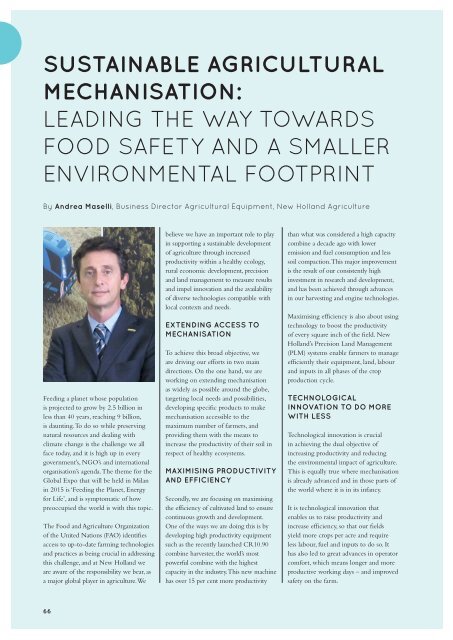Climate Action 2014-2015
You also want an ePaper? Increase the reach of your titles
YUMPU automatically turns print PDFs into web optimized ePapers that Google loves.
SUSTAINABLE AGRICULTURAL<br />
MECHANISATION:<br />
LEADING THE WAY TOWARDS<br />
FOOD SAFETY AND A SMALLER<br />
ENVIRONMENTAL FOOTPRINT<br />
By Andrea Maselli, Business Director Agricultural Equipment, New Holland Agriculture<br />
Feeding a planet whose population<br />
is projected to grow by 2.5 billion in<br />
less than 40 years, reaching 9 billion,<br />
is daunting. To do so while preserving<br />
natural resources and dealing with<br />
climate change is the challenge we all<br />
face today, and it is high up in every<br />
government’s, NGO’s and international<br />
organisation’s agenda. The theme for the<br />
Global Expo that will be held in Milan<br />
in <strong>2015</strong> is ‘Feeding the Planet, Energy<br />
for Life’, and is symptomatic of how<br />
preoccupied the world is with this topic.<br />
The Food and Agriculture Organization<br />
of the United Nations (FAO) identifies<br />
access to up-to-date farming technologies<br />
and practices as being crucial in addressing<br />
this challenge, and at New Holland we<br />
are aware of the responsibility we bear, as<br />
a major global player in agriculture. We<br />
believe we have an important role to play<br />
in supporting a sustainable development<br />
of agriculture through increased<br />
productivity within a healthy ecology,<br />
rural economic development, precision<br />
and land management to measure results<br />
and impel innovation and the availability<br />
of diverse technologies compatible with<br />
local contexts and needs.<br />
EXTENDING ACCESS TO<br />
MECHANISATION<br />
To achieve this broad objective, we<br />
are driving our efforts in two main<br />
directions. On the one hand, we are<br />
working on extending mechanisation<br />
as widely as possible around the globe,<br />
targeting local needs and possibilities,<br />
developing specific products to make<br />
mechanisation accessible to the<br />
maximum number of farmers, and<br />
providing them with the means to<br />
increase the productivity of their soil in<br />
respect of healthy ecosystems.<br />
MAXIMISING PRODUCTIVITY<br />
AND EFFICIENCY<br />
Secondly, we are focusing on maximising<br />
the efficiency of cultivated land to ensure<br />
continuous growth and development.<br />
One of the ways we are doing this is by<br />
developing high productivity equipment<br />
such as the recently launched CR10.90<br />
combine harvester, the world’s most<br />
powerful combine with the highest<br />
capacity in the industry. This new machine<br />
has over 15 per cent more productivity<br />
than what was considered a high capacity<br />
combine a decade ago with lower<br />
emission and fuel consumption and less<br />
soil compaction. This major improvement<br />
is the result of our consistently high<br />
investment in research and development,<br />
and has been achieved through advances<br />
in our harvesting and engine technologies.<br />
Maximising efficiency is also about using<br />
technology to boost the productivity<br />
of every square inch of the field. New<br />
Holland’s Precision Land Management<br />
(PLM) systems enable farmers to manage<br />
efficiently their equipment, land, labour<br />
and inputs in all phases of the crop<br />
production cycle.<br />
TECHNOLOGICAL<br />
INNOVATION TO DO MORE<br />
WITH LESS<br />
Technological innovation is crucial<br />
in achieving the dual objective of<br />
increasing productivity and reducing<br />
the environmental impact of agriculture.<br />
This is equally true where mechanisation<br />
is already advanced and in those parts of<br />
the world where it is in its infancy.<br />
It is technological innovation that<br />
enables us to raise productivity and<br />
increase efficiency, so that our fields<br />
yield more crops per acre and require<br />
less labour, fuel and inputs to do so. It<br />
has also led to great advances in operator<br />
comfort, which means longer and more<br />
productive working days – and improved<br />
safety on the farm.<br />
66












